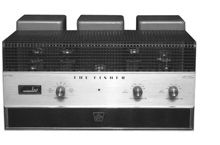 |
Fisher SA-1000/K-1000 stereo power amplifier (1962) |
|
THE EQUIPMENT: Fisher K-1000, a basic or power amplifier available in kit form. Supplied with metal cage. Dimensions: l5¼ by 7¾ by 12 inches. Weight: 71 pounds. Price: $279.50. (Factory-built version, Model SA-1000, $329.50.) Manufacturer: Fisher Radio Corp., 21-21 44th Drive, Long Island City, N.Y., 1101. COMMENT: The K-1000 is the largest and most powerful amplifier yet offered by Fisher. Tests of a kit-built sample, conducted at United States Testing Company, Inc., indicate that it meets its power and distortion specifications with room to spare. The output circuit uses a new type of tube, the 8417, which was designed especially for this amplifier and which is energized by three separate power supplies, one each for plate, screen-grid, and control-grid voltages. The input stage uses an unconventional circuit designed with wide-band characteristics and associated with a step-type attenuator designed to control signal level without rolling off the high frequency response. There also is a subsonic filter to prevent overloading the amplifier with low-frequency noise sources. The input attenuators (one for each channel) are on the front panel of the K-1000, along with a pilot lamp, a meter, and another knob for adjusting the output tubes. Also on the front panel, but concealed behind a hinged section, are the screw-adjustments for bias and balance, as well as the subsonic filter switch. The rear of the amplifier has two pairs of left and right input jacks, a test jack, a fuse-holder, and left and right speaker terminals of 4, 8, and 16 ohms. Separate grounding terminals also are included on the speaker terminal strips. No off/on switch is provided; the K-1000 is intended for use with a control unit that has an AC convenience outlet into which the K-1000's line cord would be plugged so that both units are turned on or off together.
The hardiness of this amplifier is indicated by the fact that USTC measured its continuous power at the same level specified by Fisher for its music power rating (the former usually is lower). Harmonic distortion was found to be very low at all power levels. IM distortion remained below 0.5% up to 60 watts output, and rose to only 0.6% at 65 watts output. Frequency response extended well beyond the 20 to 20,000cps range. When the subsonic switch was in the OFF position, the bass response was flat down to 7 cps. When ON the filter caused the extreme low end to fall off more rapidly, but not until well below 20 cps. The 5-position attenuator—which may be used to adjust the amplifier's gain to suit different input signal levels and to help balance the two stereo channels— made a difference of about 1 dB in the response past 20,000 cps, thus confirming the manufacturer's claim that its use will not cause high frequency degradation. Square-wave response of the K-1000 was very good. The low-frequency photos show one slight tilt and the more pronounced tilt when the subsonic filter was OFF and ON respectively; the high frequency photo shows only a slight ringing and is indicative of good stability and transient response. The difference in power bandwidth measured on the two channels is not very important, and means only that the left channel distortion may be slightly higher than that of the right when the amplifier is called on to deliver maximum power above 10 kc—a situation relatively infrequently encountered in normal program reproduction. The Fisher K-1000, in sum, is one of the better basic amplifiers available today, being an extremely high-powered unit with very low distortion, and offering such "response-tailoring" features as an input filter and attenuator that do not compromise its important performance characteristics.
How It Went Together The K-1000 was a pleasure to build, because of the superb packaging of the kit, the excellent instruction manual, and the good physical layout of the chassis. Some errors were encountered in the early edition of the manual; these, we are told, have been corrected in current versions. Total construction time was about ten hours. |
|||
 Taken
from 'High Fidelity' magazine, June 1964
Taken
from 'High Fidelity' magazine, June 1964
